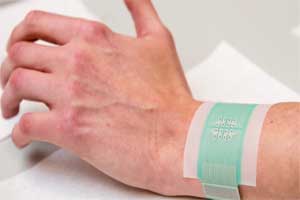- Home
- Editorial
- News
- Practice Guidelines
- Anesthesiology Guidelines
- Cancer Guidelines
- Cardiac Sciences Guidelines
- Critical Care Guidelines
- Dentistry Guidelines
- Dermatology Guidelines
- Diabetes and Endo Guidelines
- Diagnostics Guidelines
- ENT Guidelines
- Featured Practice Guidelines
- Gastroenterology Guidelines
- Geriatrics Guidelines
- Medicine Guidelines
- Nephrology Guidelines
- Neurosciences Guidelines
- Obs and Gynae Guidelines
- Ophthalmology Guidelines
- Orthopaedics Guidelines
- Paediatrics Guidelines
- Psychiatry Guidelines
- Pulmonology Guidelines
- Radiology Guidelines
- Surgery Guidelines
- Urology Guidelines
New non invasive testing patch for continuous blood glucose monitoring

Researchers at KTH Royal Institute of Technology in Sweden have designed a microneedle patch for people with diabetes to enable them to monitor their glucose levels throughout the day in a "painless" manner. The new device in addition to being painless is very small and convenient to use.
The World Health Organization has reported that nearly 422 million adults were diagnosed with diabetes in 2014. Millions of people have lost their lives because of poorly controlled blood glucose. Regulated and continuous glucose monitoring (CGM) of diabetes patients can provide better monitoring and control of blood glucose and prevent complications
Continuous monitoring is a way to safely and reliably lower blood glucose - giving the user a full picture of their glucose levels throughout the day and helping them avoid severe hypoglycemia.
The life of a person living with diabetes is more difficult than many people realize and the researchers have sought to make life a little easier for such people by developing an easier way to test their glucose levels. The currently used continuous glucose monitoring systems (known as CGMS) are uncomfortable since they require a minimum 7mm needle inserted into the skin. Owing to their size, they take measurements in the fat tissue - not the most ideal location.
"Our solution is painless to the user. We measure directly in the skin, and there are no nerve receptors that detect pain - just a fine mesh of very tiny blood vessels," Federico Ribe, a doctoral student at the institute, said.
Unlike commercially available CGMS which measure the subcutaneous fat tissue, the new device measures within the skin less than 1mm deep, Ribet said.
This would offer an alternative to pricking one's fingers several times a day to take a blood test and the frequency of finger prick tests could be reduced with a glucose monitoring system, he noted.
The team has successfully tested the prototype of a microneedle patch on a human participant and the completion of a system for clinical tests is now underway.

Disclaimer: This site is primarily intended for healthcare professionals. Any content/information on this website does not replace the advice of medical and/or health professionals and should not be construed as medical/diagnostic advice/endorsement or prescription. Use of this site is subject to our terms of use, privacy policy, advertisement policy. © 2020 Minerva Medical Treatment Pvt Ltd